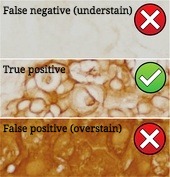
Immunohistochemistry (IHC) has been the gold standard technique for cancer diagnostics and treatment choice for the past several decades. Immunostaining produces chromatic signal by exposing a tissue to antibodies. The quality of the stain depends on staining process parameters, i.e. the concentration of the used antibody and the incubation time of the antibodies on the tissue. Non-optimal staining process parameters may lead to difficult-to-interpret staining and therefore potential misdiagnosis. Currently, pathology laboratories determine the staining parameters manually, resulting in a subjective result. Such a manual process comprising trial-and-error is cumbersome and tissue exhaustive. It is characterized by high inter- and intra-laboratory variability, leading to poor standardization and reproducibility. Thus, in this work we developed a framework to objectively standardize immunostaining by contextual quantitative analysis and to optimize staining process parameters minimizing tissue use.
Existing studies for quantitative analysis of immunostaining quality propose relative quality estimates with respect to either a user-defined threshold or a reference specimen, limiting the standardization and the reproducibility of the process. Our framework trains staining quality metrics by using reference standards for quality labeling and uses the trained metrics to objectively assess the staining quality during the testing phase, thereby eliminating the need of reference specimen for a posterior quality evaluation. Although our methodology does still require an external standard, it has the advantage of reducing dependency on it in the daily practice. Addressing IHC assay limitations, we use a microfluidic probe to create multiple assay conditions on the same tissue section. Then, staining quality is assessed objectively for multiple assay conditions using the trained staining quality metrics. Additionally, we propose to optimize staining process parameters by analyzing the optimality and sensitivity of quality scores with respect to assay parameters. Upon evaluation, our approach demonstrated to produce improved immunostained tissues compared to the current clinical staining approach.

